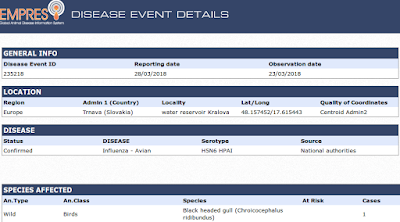#13,233
The 2014-15 flu season was remarkable both not only for its unusually severe, and recently mutated H3N2 virus (see CDC HAN Advisory On `Drifted’ H3N2 Seasonal Flu Virus) - but also for a multi-state cluster of non-mumps parotitis, ostensibly linked to influenza infection.
The classic cause of parotitis is the mumps virus, but other viruses (EBV & HIV), along with acute bacterial parotitis or Extrapulmonary Tuberculosis can cause inflammation of these glands, as well as some autoimmune diseases.In early January of 2015, the Chicago Department of Public Health issued an alert to local doctors to test for both influenza, and mumps, when diagnosing parotitis, as several unusual influenza-related cases had surfaced (see Unusual Presentation Of Parotitis With Seasonal Influenza).
The following month, the CDC published an overview of the 2014-15 flu season, with the following comment on these parotitis cases.
What You Should Know for the 2014-2015 Influenza Season
(excerpt)
Is there any unusual disease activity going on this season?
Since December 2014, multiple states have notified CDC of laboratory-confirmed influenza infections in persons who have swelling of their salivary glands (a condition called ‘parotitis’). Of the cases of influenza infection with parotitis that have been reported to CDC, the majority have occurred in children with influenza A (H3) infection, and have resulted in mild illness. No deaths have been reported. CDC is currently investigating the situation in order to understand the characteristics of patients and the occurrence of parotitis.Aside from a 2016 Eurosurveillance: Parotitis Associated With A Drifted A/H3N2 Infection report which looked at a small number of similar cases in the UK, we've not heard much about this event (or seen a recurrence) over the past 3 years.
That is - until yesterday - when Clinical Infectious Diseases published two studies - led by the CDC's EID (Epidemic Intelligence Service) - and an editorial comment on their findings.
Fair warning: these studies are both lengthy and fairly technical, and you'll probably need to devote an hour or more to read them in their entirety.The studies are:
Non-mumps Viral Parotitis During the 2014–2015 Influenza Season in the United States
Lina I Elbadawi Pamela Talley Melissa A Rolfes Alexander J Millman Erik Reisdorf Natalie A Kramer John R Barnes Lenee Blanton Jaime Christensen Stefanie Cole
Clinical Infectious Diseases, ciy137, https://doi.org/10.1093/cid/ciy137
Published: 30 March 2018
Abstract
(Continue . . . .)
Influenza-Associated Parotitis During the 2014–2015 Influenza Season in the United States
Melissa A Rolfes Alexander J Millman Pamela Talley Lina I Elbadawi Natalie A Kramer John R Barnes Lenee Blanton Jeffrey P Davis Stefanie Cole John J Dreisig ...
Clinical Infectious Diseases, ciy136, https://doi.org/10.1093/cid/ciy136
Published: 30 March 2018
Abstract
Background
During the 2014–2015 influenza season in the United States, 256 cases of influenza-associated parotitis were reported from 27 states. We conducted a case-control study and laboratory investigation to further describe this rare clinical manifestation of influenza.
Methods
During February 2015–April 2015, we interviewed 50 cases (with parotitis) and 124 ill controls (without parotitis) with laboratory-confirmed influenza; participants resided in 11 states and were matched by age, state, hospital admission status, and specimen collection date. Influenza viruses were characterized using real-time polymerase chain reaction and next-generation sequencing. We compared cases and controls using conditional logistic regression. Specimens from additional reported cases were also analyzed.
Results
Cases, 73% of whom were aged < 20 years, experienced painful (86%), unilateral (68%) parotitis a median of 4 (range, 0–16) days after onset of systemic or respiratory symptoms. Cases were more likely than controls to be male (76% vs 51%; P = .005). We detected influenza A(H3N2) viruses, genetic group 3C.2a, in 100% (32/32) of case and 92% (105/108) of control specimens sequenced (P = .22). Influenza B and A(H3N2) 3C.3 and 3C.3b genetic group virus infections were detected in specimens from additional cases.
Conclusions
Influenza-associated parotitis, as reported here and in prior sporadic case reports, seems to occur primarily with influenza A(H3N2) virus infection. Because of the different clinical and infection control considerations for mumps and influenza virus infections, we recommend clinicians consider influenza in the differential diagnoses among patients with acute parotitis during the influenza season.
(Continue . . . )
While influenza H3N2 was the most commonly identified virus among 210 patients with adequate samples for testing, it was far from alone. According to the first study:
. . . ≥ 2 viruses were detected in 37 samples, and 248 total virus detections were made among all samples. These included 156 influenza A(H3N2), 42 HHV6B, 32 EBV, 8 HPIV2, 2 HPIV3, 3 adenovirus, 4 HSV-1, and 1 HSV-2.
Influenza A(H3N2), HHV6B, and EBV were the most frequently codetected viruses.The accompanying editorial Is Parotitis One More Complication of Influenza? The Ongoing Challenge of Determining Causal Associations by Andrew T Pavia briefly summarizes both studies, examines the sometimes inconsistent findings, and reminds us of how high the bar is purposefully set (i.e. The Bradford Hill criteria) to establish causation.
In the absence of experimental data or the demonstration that influenza virus replicates in salivary glands, it will be hard to prove to a high degree of scientific certainty that influenza causes parotitis. There are potential weaknesses in both of the current studies [5, 6], including case finding strategies leading to an increased prevalence of influenza cases in the sample, selection bias, the use of buccal swab specimens alone, and the limited ability to completely exclude mumps or bacterial infection.
However, the contributions of Elbadawi, Rolfes, and colleagues strongly suggest that parotitis can be added to the long list of syndromes caused by influenza.
While not definitive, this is another reminder that influenza can surprise us and present in unusual ways, and it is more than just a respiratory virus.















